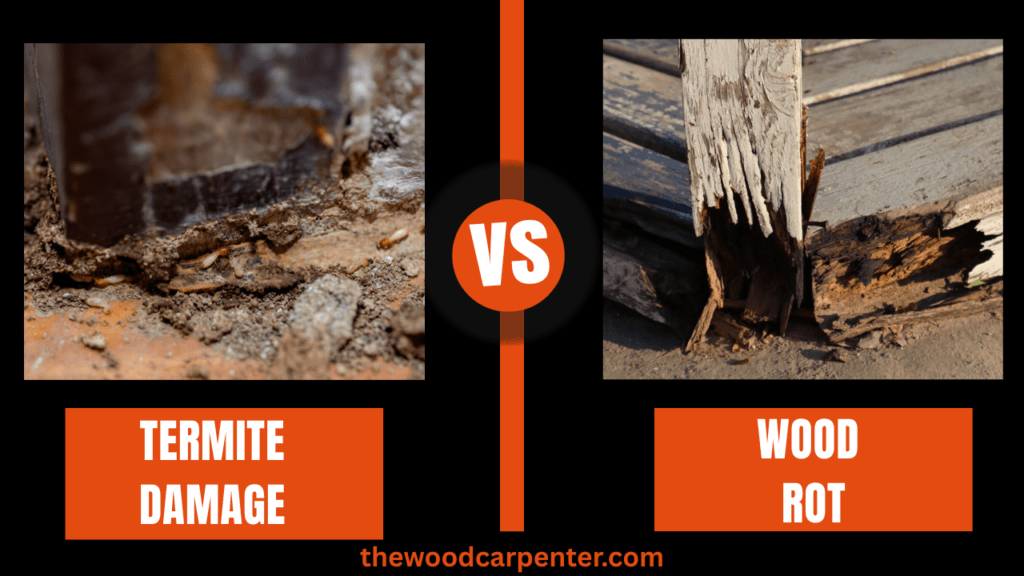
Termite damage and wood rot are two common issues that can harm the wooden parts of your home. Both can weaken your home’s structure, but they are caused by different things and need different treatments.
Knowing the difference between the two is important to fix the problem properly and keep your home safe in the long run.
What Is Termite Damage ?
What Causes Termite Damage ?
Termite damage happens when termites—tiny insects that eat wood—get into your home. They feed on wood, paper, and other things made from cellulose (a part of plants).
There are different types of termites:
- Subterranean termites live underground
- Drywood termites live inside dry wood
- Dampwood termites prefer moist wood
These insects chew through wood from the inside, so the damage often isn’t seen until it’s serious.
How Termites Attack Wood
Consumption from Inside: Termites hollow out wood, often leaving the outer surface intact.
Tunnels and Galleries: They create narrow, maze-like tunnels (galleries) through the wood.
Mud Tubes: Subterranean termites build mud tubes on walls or foundations to stay moist and protected as they travel.
Discernible Signs: Damage often makes wood sound hollow when tapped or causes paint and finishes to blister or bubble.
Common Signs of Termite Damage
- Wood that sounds hollow or papery when tapped
- Tiny holes or tunnels inside wood
- Presence of discarded wings near windows and doors
- Mud tubes along walls, foundations, or crawl spaces
- Frass (termite droppings) near infested wood
- Stuck windows or doors due to warped wood from internal damage
- Unexplained clicking sounds in walls (termites signaling danger)
- Buckling floors or ceilings, cracked or bubbling paint
What Is Wood Rot ?
What Causes Wood Rot?
Wood rot happens when a certain type of fungus (a living organism like mold) starts breaking down wood. This usually happens when the wood stays wet for too long. There are two main types of wood rot:
Wet Rot: Happens when wood is always damp. The fungus eats away at the wood, making it soft and spongy. You may also see color changes.
Dry Rot: Caused by a special kind of fungus (often called Serpula lacrymans). Even though it starts in a damp area, it can spread to dry areas by pulling moisture from the air or other materials. It can even grow through brick or concrete and ruin nearby wood.
How Wood Rot Damages Wood
Weakens the Wood: The fungus eats the wood, making it soft, crumbly, and not strong enough to hold weight.
Looks Different: Rotted wood may turn black, brown, or have other color changes. You may also notice fungus growing on it.
Smells Musty: Wood with rot often has a strong, musty or moldy smell, especially if the damage is bad.
Common Signs of Wood Rot
- Spongy, soft, or crumbly wood
- Warped or swollen wooden surfaces
- Bubbling, peeling, or flaking paint and finishes
- Gaps between boards or beams
- Discoloration (brown, black, or white areas)
- Visible fungal growth (white mycelium or mushroom-like bodies)
- Persistent musty smell
- Cracks running across wood grain
Key Differences Between Termite Damage and Wood Rot
| Feature | Termite Damage | Wood Rot |
| Cause | Insect infestation | Fungal infection due to excess moisture |
| Appearance | Hollow tunnels, mud tubes, discarded wings, internal destruction | Soft, crumbly wood, discoloration, fungal growth, external surface damage |
| Texture | Often feels hollow, with thin outer shell | Feels soft, spongy, and may crumble easily |
| Location | Anywhere, especially ground contact, walls, floors | Moist/damp areas—bathrooms, basements, sills |
| Odor | Sometimes a musty smell | Strong musty or moldy odor |
| Spread | Can affect all wood, will move to new wood | Needs high moisture, usually localized |
| Repair | Requires pest extermination, wood often replaced | Remove moisture, replace rotted wood, treat fungus |
| Health Risk | Minimal, except for allergen risk | Mold/fungi can worsen respiratory issues |
How to Identify: Step-By-Step
Check for Termite Damage
Tap and Listen: Knock on suspected areas. Hollow sounds often mean termite tunnels.
Look for Mud Tubes: Subterranean termites create tubes along walls, foundations, and crawl spaces.
Inspect for Swarmers/Wings: Find discarded wings near windows—an early sign of infestation.
Frass or Droppings: Small, pellet-like piles nearby mean drywood termites.
Check Structure: Floors or doors suddenly stiffen or warp.
Check for Wood Rot
Examine Paint and Finishes: Blistering, bubbling, or peeling paint may hide rot.
Poke the Wood: Use a screwdriver to test softness or crumble.
Visual Inspection: Look for fungus, cracking, or color changes.
Smell: A musty, earthy odor points to rot—especially if accompanied by visible fungus or discoloration.
Damage Comparison
Damage to the Structure
- Both termite damage and wood rot can be serious.
- Termites, if not treated quickly, can destroy important parts of your home like support beams, floor joists, and even walls.
- Dry rot spreads fast and can also cause major damage, especially if there is too much moisture.
Repair Costs
Termite problems often need a professional pest control service, and in bad cases, parts of the house may need to be rebuilt or replaced.
Wood rot can sometimes be repaired easily if found early. But if the damage is bad, all the rotted wood must be cut out and replaced, which can be costly.
Prevention
Preventing Termite Damage
- Keep all wood, lumber, and firewood away from the building foundation.
- Fix all leaks (roof, pipes, HVAC units).
- Seal foundation cracks and window gaps.
- Direct water away from the home (proper grading, functional gutters).
- Use termite-resistant wood or pressure-treated timber.
- Schedule regular professional inspections, especially in prone regions.
Preventing Wood Rot
- Maintain dry conditions—ventilate bathrooms, kitchens, and basements.
- Repair any leaks promptly.
- Seal windows, doors, and joints with quality caulking.
- Ensure gutters and downspouts are clear and functioning.
- Regularly inspect painted or sealed exterior wood.
- Keep shrubs and trees planted at a safe distance from wooden structures.
FAQs: Termite Damage vs Wood Rot
1. How can I tell if it’s termites or wood rot?
Look for signs:
- Termites leave behind the mud tunnels, tiny holes & sometimes shed wings.
- Wood rot makes the wood soft, crumbly, or discolored. It may also smell musty.
- Use how it looks, feels, and smells to help figure out the cause.
2. Is termite damage worse than wood rot?
Both are serious.
- Termite damage can spread fast and deep without being seen.
- Dry rot can also spread quickly and damage large areas if you don’t fix the moisture problem soon.
3. Can termites eat rotted wood?
Yes. Termites like moist, damaged wood, so they may be found in wood that already has rot.
To stop both problems, fix any leaks or moisture issues.
4. Does pressure-treated wood stop termites and rot?
Pressure-treated wood is made to resist both termites and rot better than regular wood.
But you should still check it often and keep it dry to stay safe.
5. Can I fix termite or rot damage by myself?
Small wood rot spots can be repaired with wood filler or by replacing the bad part.
Termite damage is trickier. If the damage is big or the termites are still around, you need a professional to treat and repair it.
6. What are signs of wood rot?
Look for wood that is:
- Soft or spongy
- Dark, flaky, or breaking apart
- Smells musty
- Has mold or fungus growing on or near it
7. Do termites cause rot, or is it the other way around?
No, termites don’t cause rot, and rot doesn’t cause termites.
But both often happen in the same places—like in wet, damaged wood. Keeping wood dry and sealed helps prevent both.
Final Thoughts:
Knowing the difference between termite damage and wood rot is important to keep your home safe.
Termites are bugs that eat wood from the inside, often without being noticed.
Wood rot is caused by the fungus that grows in wet wood.
Both can do serious damage but need different repairs and prevention methods.
Check your home regularly, fix leaks or wet spots quickly, and get help early if you see signs.
By acting early, you can protect your home and avoid big repair costs later.

